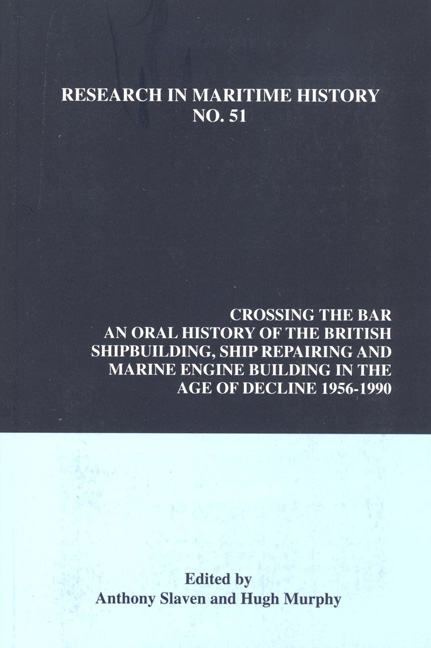 Crossing the Bar
Crossing the Bar Book contents
- Frontmatter
- Contents
- About the Authors
- Dedication
- Preface: A Shipbuilding Libretto
- Introduction
- Interviews
- Lower Clyde
- Upper Clyde
- The Tyne
- 16 G.H.R. Towers, John Redhead and Sons Ltd.
- 17 J.E. Steele, Swan Hunter, British Shipbuilders Plc
- 18 Peter Milne, Swan Hunter, British Shipbuilders Plc
- 19 P.D. Christie, Swan Hunter
- 20 James Jardine, Smith's Dock, Swan Hunter
- 21 Eric Crowdy, Hawthorn Leslie, George Clark NEM, William Doxford Engineers
- 22 M.F. Pyman, Mercantile Dry Dock Co. Ltd., Jarrow
- The Wear
- Barrow-in-Furness
- The South Coast
- The Humber
- Belfast
- British Shipbuilding Industry Officials
- The Trade Unions
- The Civil Servants, Board of Trade, Shipbuilding Enquiry Committee, Shipbuilding Industry Board, Ministry of Technology, Department of Trade and Industry, Department of Industry
- The Politicians
- Interviews British Shipbuilders Plc
- Conclusion
- Select Bibliography
21 - Eric Crowdy, Hawthorn Leslie, George Clark NEM, William Doxford Engineers
from The Tyne
- Frontmatter
- Contents
- About the Authors
- Dedication
- Preface: A Shipbuilding Libretto
- Introduction
- Interviews
- Lower Clyde
- Upper Clyde
- The Tyne
- 16 G.H.R. Towers, John Redhead and Sons Ltd.
- 17 J.E. Steele, Swan Hunter, British Shipbuilders Plc
- 18 Peter Milne, Swan Hunter, British Shipbuilders Plc
- 19 P.D. Christie, Swan Hunter
- 20 James Jardine, Smith's Dock, Swan Hunter
- 21 Eric Crowdy, Hawthorn Leslie, George Clark NEM, William Doxford Engineers
- 22 M.F. Pyman, Mercantile Dry Dock Co. Ltd., Jarrow
- The Wear
- Barrow-in-Furness
- The South Coast
- The Humber
- Belfast
- British Shipbuilding Industry Officials
- The Trade Unions
- The Civil Servants, Board of Trade, Shipbuilding Enquiry Committee, Shipbuilding Industry Board, Ministry of Technology, Department of Trade and Industry, Department of Industry
- The Politicians
- Interviews British Shipbuilders Plc
- Conclusion
- Select Bibliography
Summary
I had always been interested in marine matters. I did two years at Cambridge during the war which culminated in a wartime degree. After the war, I went to the University Appointments Board, and the then Managing Director of Hawthorn Leslie Engineers, Sir Philip Johnson, asked me if I would be interested in joining them, so I did. I had various appointments at Hawthorn Leslie Engineers, who were a subsidiary company of Hawthorn Leslie Shipbuilders. I was ultimately appointed Managing Director in 1972.
Post 1972, we traded profitably for some years until it became fairly apparent that, quite apart from the threat of nationalisation, there was a radical change coming into the industry. At Hawthorn Leslie we looked at ways of strengthening our position. We tried to go into a merger with Smith's Dock on the Tees. That foundered because the brilliant financial characters did not realise that our shares were ten shillings each, instead of a pound, and this obviously changed all the valuations on which the negotiations were conducted, and completely aborted the whole affair at a very late stage. Around the time we also decided that manufacturing marine main engines under licence was extremely difficult. The only feature you could compete on was price. One could not claim any design advantage. We had licences at that time from sundry firms, including Doxford [the only indigenous designer and manufacturer ofmarine slow-speed diesels in the UK]. We were also a Pametrada [ParsonsMarine Turbine Research and Development Association, Wallsend] member. We sought to widen our turbine manufacturing capability. We then decided that the only possible scope was to get more involved in design so that we could offer something different to the standard products of the licensors. To cut a long story short, we got into cahoots with Doxford to design the Seahorse engine. That was a medium speed diesel main engine, which at the time was in a class by itself. It took longer to develop that it should have done, as we did not always agree. We wanted to break into the power generation market and this was the driving force behind Seahorse.
The Seahorse engine project proceeded until one or two events altered developments. The principle one was that Court Line took over Doxford, and not very long after [1974] went into liquidation.
- Type
- Chapter
- Information
- Crossing the BarAn Oral History of the British Shipbuilding, Ship Repairing and Marine Engine-Building Industries in the Age of Decline, 1956-1990, pp. 82 - 87Publisher: Liverpool University PressPrint publication year: 2013
